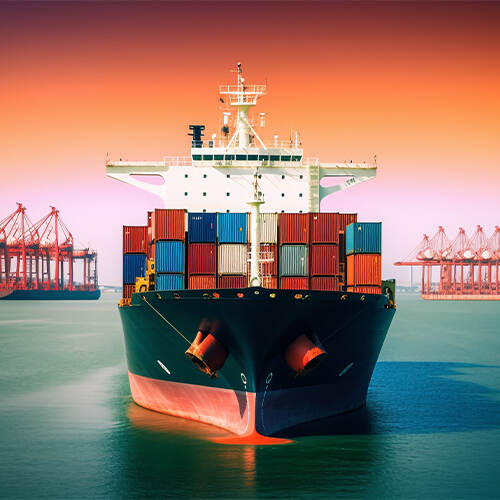Navigating the Seas of Global Trade: Insights into Sea Freight Transport Services
Introduction
Sea freight transport services play a pivotal role in the global economy, facilitating the movement of goods across continents with efficiency and reliability. This article explores several critical aspects of sea freight logistics, from route optimization and trade lanes to risk management, multimodal integration, cold chain logistics, and the digital transformation revolutionizing the industry.
I. Route Optimization and Trade Lanes
Trade routes are the lifeblood of sea freight transport, connecting major economic regions and enabling the flow of goods on a massive scale. Optimization of these routes is crucial for enhancing efficiency and cost-effectiveness in logistics operations.
Major trade lanes such as the Asia-Europe and Trans-Pacific routes are central to global supply chains. The Asia-Europe trade lane, for instance, spans vast distances and links manufacturing hubs in Asia with consumer markets in Europe. It serves as a backbone for international trade, handling a diverse range of commodities from electronics to automotive parts. Similarly, the Trans-Pacific trade lane connects Asia-Pacific exporters with markets in North America, facilitating the exchange of goods ranging from textiles to machinery.
Efforts in route optimization focus on minimizing transit times, reducing fuel consumption, and optimizing vessel capacity utilization. Advanced planning and utilization of data-driven analytics help shipping companies adjust routes based on factors like weather patterns, fuel costs, and port congestion, thereby ensuring timely delivery and cost-efficiency.
II. Risk Management in Sea Freight
Sea freight transport is not without its risks, which can significantly impact supply chain operations. Piracy remains a concern in certain maritime regions, necessitating robust security measures and collaboration with international maritime authorities. Weather-related disruptions, such as hurricanes and typhoons, can cause delays and damage to cargo, requiring contingency plans and insurance coverage to mitigate financial losses.
Moreover, geopolitical tensions and trade disputes can disrupt sea freight routes and impact shipping schedules. Strategies to manage these risks include diversifying trade routes, maintaining open communication with stakeholders, and leveraging technology for real-time tracking and monitoring of cargo movements. Collaborative efforts between shipping companies, port authorities, and governments are essential for ensuring the security and stability of sea freight operations.

III. Multimodal Transportation Integration
The integration of sea freight with other modes of transportation—such as rail, road, and air—is essential for creating seamless logistics solutions. Multimodal transportation offers benefits such as enhanced flexibility, reduced transit times, and improved cost-efficiency by optimizing each mode's strengths.
For example, integrating sea freight with rail transport enables efficient inland distribution of goods from ports to final destinations. Road transport complements sea freight by providing last-mile connectivity, especially for perishable goods and time-sensitive shipments. Air freight integration is crucial for high-value and urgent cargo, offering expedited delivery options that complement sea transport's affordability and capacity advantages.
However, achieving effective multimodal integration poses challenges, including infrastructure compatibility, regulatory harmonization across different transport modes, and ensuring smooth intermodal transfers. Addressing these challenges requires collaborative efforts from stakeholders across the logistics chain, supported by investments in infrastructure and technology.
IV. Cold Chain Logistics
Cold chain logistics in sea freight is dedicated to transporting perishable goods that require temperature-controlled environments throughout their journey. This specialized segment of sea freight logistics ensures the integrity and quality of goods like fresh produce, pharmaceuticals, and chemicals, which are sensitive to temperature variations.
Key components of cold chain logistics include temperature-controlled containers equipped with advanced monitoring systems to maintain specific temperature ranges. Regulatory compliance with international standards ensures the safe transport of perishable goods, addressing health and safety regulations in different countries. The growth of refrigerated shipping reflects increasing global demand for fresh food products and pharmaceuticals, driving innovation in cold chain technologies and infrastructure.
Advancements in cold chain logistics enhance efficiency and reliability, reducing food wastage and maintaining product quality from farm to fork. However, challenges such as energy consumption, infrastructure gaps, and compliance with evolving regulations underscore the complexity of managing cold chain logistics in sea freight operations.
V. Digital Transformation in Shipping
Digital transformation is reshaping sea freight transport services, introducing technologies that enhance operational efficiency, transparency, and customer satisfaction. Blockchain technology, for instance, improves supply chain transparency by securely recording transactions and tracking the movement of goods from origin to destination. It enhances trust and reduces fraud in international trade, benefiting stakeholders across the logistics ecosystem.
Artificial Intelligence (AI) plays a pivotal role in sea freight logistics by enabling predictive analytics for demand forecasting, route optimization, and inventory management. AI-driven insights empower shipping companies to make data-driven decisions, optimize fleet utilization, and minimize operational costs. Furthermore, the Internet of Things (IoT) facilitates real-time monitoring of cargo conditions, ensuring compliance with temperature-sensitive shipments and enhancing supply chain visibility.
The adoption of digital technologies in sea freight transport is accelerating, driven by the need for efficiency gains, cost reductions, and responsiveness to customer demands. However, challenges such as cybersecurity risks, data privacy concerns, and the digital divide among stakeholders require proactive strategies and investments in digital literacy and infrastructure.
VI. Conclusion
Sea freight transport services are indispensable to global trade, connecting economies and enabling the exchange of goods on a massive scale. From optimizing trade routes and managing risks to integrating multimodal transportation and advancing cold chain logistics, the industry continues to evolve in response to technological advancements and market demands.
Looking ahead, the future of sea freight transport services will be shaped by innovations in digitalization, sustainability initiatives, and collaborative efforts to address emerging challenges. By embracing technological advancements and fostering partnerships across the logistics ecosystem, stakeholders can enhance operational resilience, reduce environmental impact, and meet evolving customer expectations in the dynamic world of global trade.
In conclusion, sea freight transport services play a critical role in shaping the interconnectedness of economies worldwide, driving economic growth and prosperity through efficient and sustainable logistics solutions.


